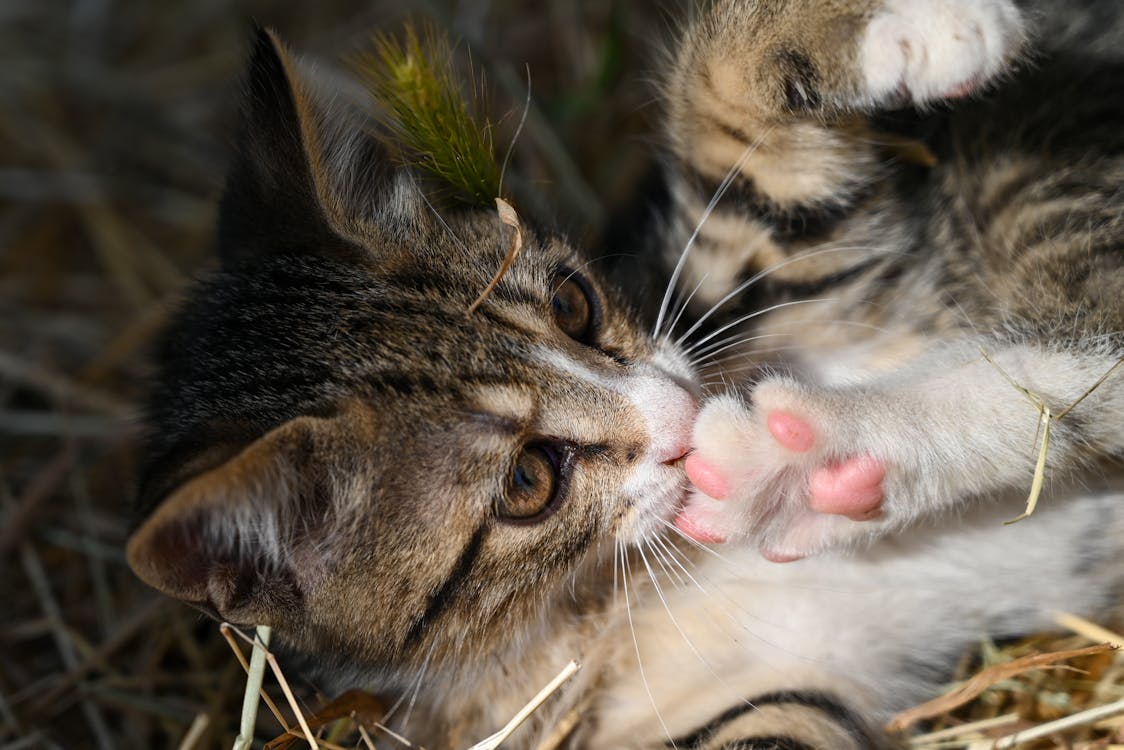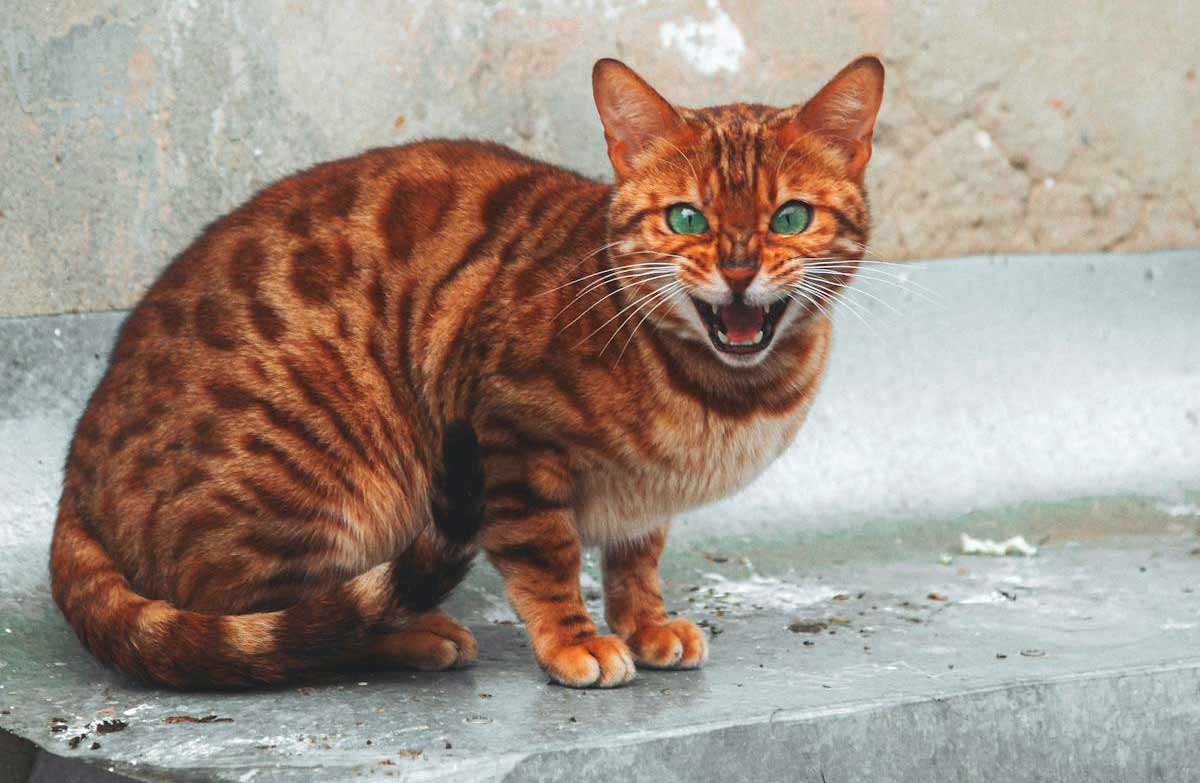Female cats spray, imagine this: you come home after a long day, ready to unwind with your beloved feline companion. As you enter the living room, a pungent odor assaults your senses. Looking around in dismay, you discover a telltale mark on your favorite armchair – your sweet, cuddly female cat has inexplicably sprayed indoors. This scenario might leave you feeling confused and frustrated. After all, isn’t spraying a behavior typically associated with male cats?
The truth is, female cats can indeed spray, challenging the common misconception that only their male counterparts engage in this behavior. While less frequent than in males, spraying in female felines can be just as perplexing for their owners. Fear not, fellow cat enthusiasts! This article serves as your comprehensive guide to understanding spraying behavior in female cats. We’ll delve into the reasons behind their spraying, explore the subtle differences between male and female spraying, and equip you with effective strategies to deter this unwanted behavior. So, grab a cup of catnip tea (or your beverage of choice!), and let’s unravel the mystery of feline spraying together.
What We’ll Cover:
- Demystifying the Reasons Why Female Cats Spray: We’ll explore the various motivations behind female feline spraying, including territorial marking, communication during heat cycles, stress-induced spraying, and even underlying medical conditions.
- Comparing and Contrasting: A Tale of Two Sprayers: This section delves into the subtle differences between spraying behavior in male and female cats, helping you identify potential triggers based on your cat’s specific situation.
- Putting a Stop to the Spray: We’ll equip you with a toolbox of effective deterrents and prevention strategies to discourage your female cat from spraying and create a harmonious living environment for all.
- Mythbusters: Feline Folklore Debunked: No guide to feline spraying would be complete without addressing some of the common myths surrounding this behavior. We’ll separate fact from fiction, empowering you to approach your cat’s spraying with knowledge and understanding.
Breaking the Mold: Why Female Cats Spray – It’s Not Just a Boy Thing!
Have you ever walked into a room and been met with an unpleasant surprise – that unmistakable scent of cat urine? While many pet owners associate spraying behavior with territorial male cats, the truth is, that female felines can also be culprits in this aromatic offense. Let’s dispel the myth that spraying is solely a male domain and delve into the reasons why your lovely lady might be marking her turf (or something else entirely!).
Beyond Marking Territory: A Symphony of Communication
Traditionally, spraying has been linked to male dominance and territorial marking. However, female cats have their own reasons for using this form of feline communication. Here are some of the key motivations:
-
Territorial Imperative: Just like their male counterparts, female cats have a strong instinct to claim their space. This is particularly true for felines living in multi-cat households or those with access to the outdoors, where they might encounter unfamiliar cats. By strategically spraying urine, female cats mark their territory and deter perceived threats, sending a message to other cats, “This is my domain, back off!”
-
The Mating Call (Not as Common, But Still Possible): While less frequent than in male cats, female felines in heat might also resort to spraying. This behavior acts as a kind of feline advertisement, a way to signal their receptivity to potential suitors. The hormones coursing through their bodies during this time can trigger this instinctual urge to leave a scented message for nearby male cats.
It’s Important to Note: Spaying your female cat significantly reduces, and often eliminates, spraying behavior linked to heat cycles.
Stress Can Be a Silent Trigger
Cats are creatures of habit, and any disruption to their routine can trigger anxiety and stress. If your seemingly well-adjusted feline companion suddenly starts spraying, consider recent changes in their environment that might be causing them distress. This could include:
-
A New Addition to the Family: Whether it’s a playful puppy or a curious kitten, introducing a new pet can be a stressful experience for your resident cat. The unfamiliar presence and altered dynamics within the household might lead them to mark their territory through spraying as a way of reclaiming a sense of security.
-
Routine Shifts: Cats thrive on predictability. Changes in your daily schedule, like a new work pattern or travel plans, can disrupt your sense of security and trigger spraying behavior.
-
Environmental Disruptions: Loud noises from construction work outside, the arrival of new furniture, or even a change in litter box location can all be sources of stress for your cat. If they feel their environment is no longer a safe haven, spraying might become a coping mechanism.
By identifying and addressing the source of stress, you can help your cat feel more secure and hopefully eliminate the need for them to resort to spraying.
Medical Concerns: Ruling Out Physical Causes
While less common, underlying medical conditions can sometimes contribute to spraying behavior in female cats. These conditions can cause discomfort or pain during urination, prompting them to spray outside the litter box. If you suspect a medical issue might be the culprit, a visit to the veterinarian is crucial. Ruling out any physical causes will ensure you’re addressing the root of the problem and providing your cat with the proper treatment.
Here are some potential medical conditions to consider:
-
Urinary Tract Infections (UTIs): UTIs can cause irritation and discomfort during urination, leading your cat to associate the litter box with a negative experience. They might then seek alternative spots to eliminate, which can manifest as spraying.
-
Bladder Stones: The presence of bladder stones can be incredibly painful for cats. Similar to UTIs, discomfort during urination might lead them to avoid the litter box and resort to spraying.
By understanding the various reasons why female cats spray, you can take steps to address the underlying cause and create a more harmonious living environment for both you and your feline friend. Remember, a visit to the veterinarian can help rule out any medical concerns and provide valuable guidance in managing your cat’s spraying behavior.
A Tale of Two Tails: Similarities and Differences in Spraying
Have you ever noticed your feline friend leaving what seems like unwelcome “messages” around the house? While spraying urine might seem like a strictly male behavior, the truth is, that female cats can also engage in this act. Understanding the reasons behind spraying, along with the subtle differences between male and female motivations, can be a valuable tool in addressing this behavior and creating a harmonious home environment for you and your cat.
Shared Messages: A Universal Language of Scent
At its core, spraying in both male and female cats serves a similar purpose: communication. These feline messages, delivered through strategically placed urine deposits, can be broadly categorized into three main themes:
-
Territorial Markings: Cats are territorial creatures, and spraying is a way for them to claim their space and deter potential intruders, feline or otherwise. By leaving their scent behind, they’re essentially saying, “This is my domain!”
-
Mating Readiness: For intact females, spraying can be a way to advertise their availability to potential mates. The hormones associated with their heat cycle trigger the urge to mark their territory and attract suitors.
-
Stressful Situations: Life can be full of unexpected twists and turns, even for our feline companions. Changes in routine, new pets in the household, or loud noises can all be sources of stress for cats. Sometimes, they resort to spraying as a way of expressing their anxiety or feeling of insecurity.
Frequency and Location: Decoding the Spray Pattern
While the overall message might be similar, there can be subtle differences in how male and female cats choose to deliver it. Here’s a closer look at some potential variations:
-
Frequency of Spraying: Generally, male cats tend to spray more frequently than females. This is likely due to the stronger influence of testosterone, the primary male sex hormone, which can drive territorial marking behavior.
-
Target Zones: Male cats often favor vertical surfaces like walls, furniture legs, or doors for their spray messages. Females, on the other hand, might spray on both horizontal and vertical surfaces. Some feline experts suggest that females spraying horizontally might be targeting specific objects or areas associated with the source of their stress.
It’s important to remember that these are just tendencies, not absolute rules. Every cat is an individual, and their spraying behavior can vary. However, being aware of these potential differences can offer some initial insights into what might be motivating your cat.
Hormonal Influences: Beyond the Heat Cycle
While estrus (heat cycle) can certainly trigger spraying in female cats, it’s not the only factor at play. Unlike males, whose spraying is heavily influenced by testosterone levels, female spraying can be caused by a wider range of hormonal fluctuations and external stressors.
Here are some additional factors that might contribute to female spraying:
-
Social Dynamics: Changes in the household hierarchy, such as the introduction of a new cat, can lead to feelings of insecurity and prompt spraying in females.
-
Medical Conditions: Underlying medical issues like urinary tract infections or bladder stones can sometimes cause a cat to spray due to discomfort or pain.
-
Environmental Changes: Moving to a new home, renovations in the house, or even a change in litter box location can all be stressful for cats and trigger spraying behavior.
Behavioral Cues: Reading the Feline Body Language
When trying to understand why your cat might be spraying, observing their behavior before, during, and after the act can provide valuable clues. Here are some things to watch for:
-
Restlessness or Agitation: A stressed or anxious cat might exhibit signs of restlessness, pacing, or dilated pupils before spraying.
-
Tail Posture: A raised tail with a quivering motion can sometimes indicate a cat feeling threatened or stressed, potentially leading to spraying.
-
Direct Gaze: If your cat seems to be staring intently at a particular spot before spraying, it might be targeting that area as a message to another animal (real or perceived).
By understanding the language of feline body language and scent-marking, you can gain valuable insights into your cat’s emotional state and potential triggers for spraying.
Stopping the Spray: Effective Deterrents and Prevention Strategies
Finding your favorite chair marked with a surprise from your feline friend can be a frustrating experience. While spraying might seem like a deliberate act of defiance, it’s important to remember that cats communicate through scent marking. Understanding the reasons behind this behavior is the first step towards creating a peaceful and spray-free coexistence.
Identifying the Root of the Issue: Cracking the Code Behind Spraying
Before implementing deterrents, it’s crucial to identify the underlying cause of your cat’s spraying behavior. Think of your cat as a tiny detective leaving messages – by understanding the “why” behind the spray, you can address the root of the problem and prevent future incidents. Here are some common reasons why cats spray:
-
Territorial Marking: Cats are territorial creatures, and spraying is a way for them to claim their space and deter perceived threats. New pets in the household, a stray cat wandering outside the window, or even a change in furniture arrangement can trigger territorial anxieties and lead to spraying.
-
Stress and Anxiety: Just like humans, cats can experience stress and anxiety. Changes in routine, loud noises or a lack of environmental enrichment can all contribute to feline stress, manifesting in spraying behavior.
-
Medical Conditions: Sometimes, spraying can be a sign of an underlying medical condition, such as a urinary tract infection, bladder stones, or hyperthyroidism. If you suspect a medical cause, consulting your veterinarian is essential for proper diagnosis and treatment.
Building a Cat-Friendly Environment: Addressing the Source of Anxiety
By creating a cat-friendly environment that addresses potential anxieties and territorial instincts, you can significantly reduce the likelihood of spraying. Here are some strategies to consider:
-
Vertical Territory: Cats feel secure when they can perch high up and survey their domain. Provide ample vertical territory with tall scratching posts, cat trees, or shelves strategically placed around the house.
-
Litter Box Bliss: Multiple, clean litter boxes are essential for feline happiness. A good rule of thumb is to have one litter box per cat, plus an extra. Experiment with different litter box types, locations, and scooping frequencies to find a setup that works best for your cat.
-
Hiding Havens: Cats feel safe in enclosed spaces. Provide cozy hiding spots like cat caves, cardboard boxes, or covered beds to help your cat feel secure and reduce stress.
-
Feliway Pheromones (Optional): Feliway diffusers release synthetic feline pheromones that mimic calming facial pheromones produced by cats. These diffusers can create a more relaxing environment for stressed felines, potentially reducing spraying behavior.
Remember, these strategies work best when implemented proactively. By creating a cat-friendly haven from the get-go, you can minimize the chances of spraying altogether.
Cleaning Up the Mess: Eliminating the Calling Card
If your cat has already sprayed, don’t despair! The key is to thoroughly clean the affected area as soon as possible. Regular cleaning products won’t suffice – they might only mask the odor, which can actually encourage further spraying. Here’s what you need to do:
-
Remove any visible residue with a paper towel or absorbent material. Wear gloves if necessary.
-
Enzyme cleaners are your best bet. These cleaners contain biological enzymes that break down the odor-causing bacteria in cat urine. Follow the product instructions carefully and allow the area to dry completely before allowing your cat back in the vicinity.
-
Avoid harsh chemicals or ammonia-based cleaners. These can actually make the problem worse by mimicking the scent of cat urine and triggering further spraying.
By thoroughly cleaning the marked area, you eliminate the lingering olfactory cue that might entice your cat to spray again.
Consulting Your Veterinarian: Ruling Out Medical Causes
If you’ve implemented these strategies and your cat continues to spray, a visit to the veterinarian is essential. Ruling out any underlying medical conditions that could be causing the spraying behavior is crucial for a successful resolution. Your veterinarian will perform a thorough physical examination and may recommend additional tests if necessary.
Seeking Professional Help: When to Call in the Experts
For complex cases or cats with severe spraying problems, consulting a professional animal behaviorist can be incredibly beneficial. A behaviorist can help you develop a customized plan to address the underlying cause of your cat’s spraying and implement effective training techniques. Remember, seeking professional help is not a sign of failure – it’s a demonstration of your commitment to creating a harmonious and stress-free environment for both you and your feline companion.

Myths Debunked: Separating Fact from Fiction
Let’s dispel some common misconceptions surrounding female cat spraying. Understanding the truth behind these myths can empower you to address the behavior effectively and create a more harmonious living environment for both you and your feline companion.
Spaying Solves All: Not Quite, But It Helps!
One of the most persistent myths is that spaying, the surgical removal of a female cat’s ovaries and uterus, automatically eliminates spraying behavior. While spaying is generally recommended for all female cats to prevent unwanted litters and potential health problems, it’s important to understand its impact on spraying is not always absolute.
Here’s a breakdown of the spaying and spraying connection:
-
Significant Reduction in Likelihood: The good news is that spaying does significantly reduce the likelihood of spraying in female cats. Studies have shown that spaying before a cat goes into heat (estrus) can dramatically decrease the chance of her ever developing this behavior.
-
Not a Guaranteed Cure: However, it’s important to remember that spaying is not a guaranteed cure for all spraying cats. Some females, particularly those who have already established a spraying habit, might continue to exhibit this behavior even after being spayed.
The Bottom Line: Spaying is a crucial part of responsible cat ownership, offering numerous health benefits for your feline friend. While it can significantly reduce spraying behavior, it’s not a magic bullet. If your spayed cat is still spraying, there might be underlying factors at play that require further investigation.
Punishment Doesn’t Work: Understanding the Root Cause
Another common misconception is that punishment is the answer to stopping spraying. The truth is, resorting to punishment like yelling or scolding your cat is not only ineffective but can actually worsen the situation. Here’s why:
-
Stressful Experience: Cats are highly sensitive creatures. Punishment creates a stressful experience for them, which can actually trigger or exacerbate spraying behavior. A stressed cat might spray more frequently as a way of coping with their anxiety.
-
Missing the Point: Punishment doesn’t address the underlying cause of the spraying. Is your cat feeling stressed by a new pet in the household? Is there a change in their litter box routine? Punishment doesn’t answer these questions, and without addressing the root cause, the spraying is likely to continue.
The Positive Approach: Instead of focusing on punishment, a positive and solution-oriented approach is key. Focus on identifying the cause of the spraying and creating a comfortable and enriching environment for your cat. We’ll explore effective strategies for addressing spraying behavior in the next section.
Declawing is the Answer: Addressing the Wrong Behavior
Finally, some pet owners might mistakenly believe that declawing, the surgical removal of a cat’s claws, can prevent spraying. This is a misconception on several levels. Here’s why declawing is not the answer:
-
Targets the Wrong Behavior: Spraying is a form of communication and territorial marking, not a scratching behavior. Declawing addresses scratching on furniture, not the underlying reasons behind spraying.
-
A Painful Procedure: Declawing is a painful and controversial surgical procedure that can have long-term health implications for cats. It can lead to arthritis, litter box aversion, and even behavioral problems.
Exploring Humane Solutions: Instead of resorting to declawing, there are numerous humane and effective ways to address scratching behavior in cats. These include providing scratching posts, using positive reinforcement techniques, and trimming your cat’s claws regularly.
By debunking these common myths and focusing on positive solutions, you can create a more peaceful and harmonious living environment for both you and your beloved feline friend.
Understanding Your Cat: Building a Stronger Bond to Prevent Spraying
Has your feline friend surprised you with a less-than-pleasant puddle or a pungent aroma on your favorite chair? While frustrating, cat spraying is a form of communication, and understanding the reasons behind it can help you address the issue and strengthen your bond with your furry companion. Let’s delve into the world of feline communication and explore ways to create a stress-free environment that discourages spraying behavior.
The Power of Communication: Decoding Your Cat’s Messages
Cats are masters of nonverbal communication, expressing their needs and emotions through body language, vocalizations, and yes, sometimes, even spraying. The key to preventing spraying is understanding what your cat might be trying to tell you. Here are some common reasons behind feline spraying and how to address them:
-
Territorial Marking: Cats are instinctively territorial creatures, and spraying can be their way of marking their domain. If you’ve recently introduced a new pet or rearranged furniture, your cat might feel insecure and resort to spraying to reassert their claim on their territory.
-
Stress and Anxiety: Changes in routine, loud noises, or even a new addition to the family can cause stress and anxiety in cats. A stressed cat might express their discomfort by spraying, leaving their scent as a way of self-soothing or marking a perceived threat.
-
Medical Issues: Sometimes, spraying can be a sign of an underlying medical condition, such as a urinary tract infection or bladder stones. If you suspect a medical cause for your cat’s spraying, a visit to the veterinarian is essential to rule out any health problems.
By observing your cat’s behavior and identifying potential stressors, you can take steps to address the root cause of the spraying and prevent future incidents.
Positive Reinforcement: Rewarding Good Choices
Imagine this scenario: Your cat uses the scratching post perfectly, leaving your furniture unscathed. Wouldn’t you want to celebrate that positive behavior? Positive reinforcement is a powerful tool in modifying feline behavior. Here’s how to use it effectively:
-
Catch Them in the Act (of Goodness): When you witness your cat using the litter box or scratching post appropriately, shower them with praise! Offer enthusiastic verbal praise, gentle petting, or a favorite treat. This positive association helps them understand that using these designated areas is the desired behavior.
-
Make Scratching Posts Irresistible: A boring scratching post won’t hold a candle to the allure of your plush armchair. Invest in a sturdy scratching post with different textures (sisal, cardboard) and consider adding catnip to entice your feline friend. Place scratching posts in various locations around your home, especially near areas they frequent. Health books, guides, exercises, habits, Diets, and more
-
Patience is Key: Remember, behavior modification takes time and consistency. Don’t get discouraged if your cat doesn’t grasp the concept immediately. Keep offering positive reinforcement for desired behaviors, and gradually, you’ll see a positive shift in their habits.
By rewarding your cat for using litter boxes and scratching posts appropriately, you encourage them to repeat these positive behaviors, minimizing the likelihood of resorting to spraying.
Building a Stress-Free Feline Paradise
Cats thrive in predictable and comfortable environments. Creating a stress-free haven for your feline companion can go a long way in preventing spraying behavior. Here are some tips for building a cat-friendly home:
-
Provide Vertical Territory: Cats feel secure when they have high vantage points to survey their domain. Invest in cat trees, shelves, or perches allowing your cat to climb and observe their surroundings.
-
Offer Hiding Spots: Cats also appreciate cozy nooks where they can retreat for a nap or feel safe during stressful situations. Provide cubbyholes, cardboard boxes, or designated hiding spots where your cat can relax undisturbed.
-
Minimize Disruptions: Loud noises or sudden changes in routine can trigger anxiety in cats. If possible, create a quiet space for your cat away from high-traffic areas or loud appliances. Maintain a consistent routine for feeding, playtime, and litter box cleaning to provide a sense of security. Cat accessories on Amazon
-
Feliway and Pheromones: Feliway diffusers release synthetic feline pheromones that mimic calming messages. These diffusers can create a more relaxing environment for your cat, potentially reducing stress-induced spraying.
By creating a safe, enriching, and stress-free environment, you address the root cause of potential anxiety in your cat, significantly reducing the likelihood of spraying behavior. Remember, a happy cat is less likely to resort to spraying as a means of communication.
Other Interesting Articles
- How To Take Care of A Baby Kitten 2 Weeks Old: 6-Step Guide
- 20 Famous People and Legends Who Loved & Had Pet Cats
- How To Tell If A Cat is Male/Boy or Female/Girl: Tips, Guide
- A Guide to Socializing Shy, Frightened, or Traumatized Cats
- How to Stop A Cat From Spraying Indoors: Home Remedies
- How to Help Cats Get Along with a Kitten Step-By-Step
- How To Tell If Your Cat Has A Triple Coat: 7 Simple Steps
- How To Tell If Your Cat Has Down Syndrome: Signs & Myths
- 11 Signs Your Cat is a Girl: Tips To Distinguish A Female Cat
- Petting A Shy Cat: A How-To Guide, Tips, Dos, Don’ts, FAQs
- How To Tell If Your Cat Has Fleas: Best Tips To Take Care
- How To Tell If Your Cat Can’t Hear: 10 Tips To Help A Deaf Cat
- Why is My Cat Making A Weird Vibrating Noise: What To Do
- How To Tell If A Shy Cat Likes You: 14 Signs To Observe
- How To Stop A Cat From Spraying Outside: 20 Tips To Try
- How To Tell If My Cat is in Pain After Surgery: 17 Implied Signs
- How to Take Care of A Kitten For the First Time: 20 Tips
- 20 Prohibited Things You Should NEVER Do To Your Pet Cat
- What to Know Before Getting a Second Cat: Tips & Guide
- What Scents and Smells Do Cats Hate? How To Deal With



